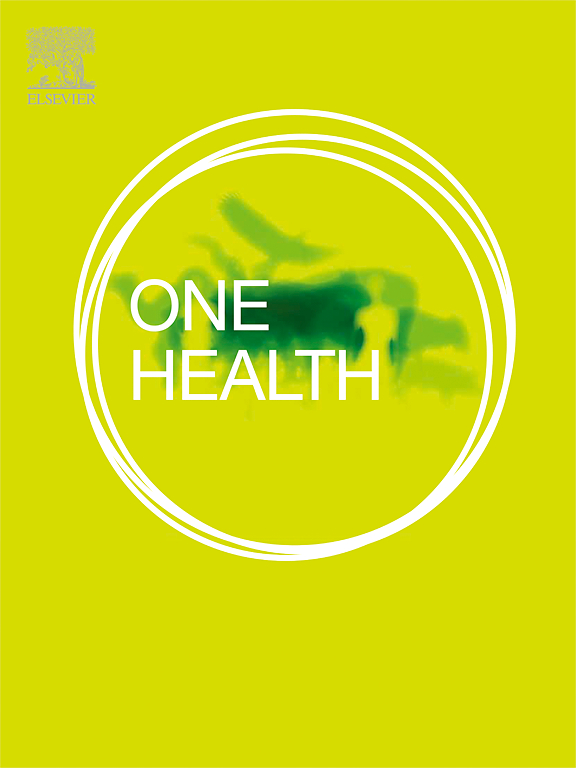2020 - 2022年泰国环境水体中人类博卡病毒的分子检测和特征分析
IF 4.5
2区 医学
Q1 INFECTIOUS DISEASES
引用次数: 0
摘要
人类博卡病毒(HBoV)是一种全球公认的与婴幼儿呼吸道和胃肠道感染相关的病原体。在临床和环境水样中检测到该病已引起人们对潜在水媒传播的关注。本研究于2020年7月至2022年12月对泰国昌迈地区环境水源中HBoV的流行情况和遗传多样性进行了调查。采用聚合酶链反应法对来自不同环境来源的600份水样进行分析。进行核苷酸测序和系统发育分析,鉴定HBoV基因型并评估其遗传特征。600份样本中有32份检测到HBoV(5.3%),这表明在COVID-19大流行期间检出率显著下降。其中,废水检出率最高(23.3%),灌溉水次之(1.2%),河水次之(0.8%)。环境水库水样未检出HBoV。所有四种已知的HBoV基因型(HBoV1-HBoV4)均被鉴定出来,其中HBoV2是最常见的基因型(19株;59.4%),其次是HBoV3(6株;18.8%), HBoV1(5株;15.6%), HBoV4(2株;6.2%)。HBoV污染没有明显的季节性特征。系统发育分析显示,环境HBoV与人类相关HBoV菌株之间存在密切的遗传关系,表明HBoV在人与环境之间存在交互传播。本研究强调了2019冠状病毒病大流行期间环境水域HBoV的流行和遗传多样性,并强调需要继续进行监测,以更好地了解其环境动态和潜在的公共卫生影响。本文章由计算机程序翻译,如有差异,请以英文原文为准。
Molecular detection and characterization of human bocavirus in environmental waters in Thailand from 2020 to 2022
Human bocavirus (HBoV) is a globally recognized pathogen associated with respiratory and gastrointestinal infections in infants and young children. Its detection in both clinical and environmental water samples has raised concerns about potential waterborne transmission. This study investigated the prevalence and genetic diversity of HBoV in environmental water sources in Chang Mai, Thailand, from July 2020 to December 2022. A total of 600 water samples from various environmental sources were analyzed using PCR assay. Nucleotide sequencing and phylogenetic analysis were performed to identify HBoV genotypes and assess their genetic characteristics. HBoV was detected in 32 of 600 samples (5.3 %), representing a notable decline in the detection rates during the COVID-19 pandemic. Among the sample types, wastewater showed highest detection rate (23.3 %), followed by irrigation water (1.2 %), and river water (0.8 %). No HBoV was detected in environmental reservoir water samples. All four known HBoV genotypes (HBoV1-HBoV4) were identified, with HBoV2 being the most prevalent genotype (19 strains; 59.4 %), followed by HBoV3 (6 strains; 18.8 %), HBoV1 (5 strains; 15.6 %), and HBoV4 (2 strains; 6.2 %). No clear seasonal pattern of HBoV contamination was observed. Phylogenetic analysis revealed a close genetic relationship between environmental and human-associated HBoV strains, suggesting an interactive transmission of HBoV between human and the environment. This study highlights the prevalence and genetic diversity of HBoV in environmental waters during the COVID-19 pandemic and underscores the need for continued surveillance to a better understanding its environmental dynamics and potential public health implications.
求助全文
通过发布文献求助,成功后即可免费获取论文全文。
去求助
来源期刊

One Health
Medicine-Infectious Diseases
CiteScore
8.10
自引率
4.00%
发文量
95
审稿时长
18 weeks
期刊介绍:
One Health - a Gold Open Access journal.
The mission of One Health is to provide a platform for rapid communication of high quality scientific knowledge on inter- and intra-species pathogen transmission, bringing together leading experts in virology, bacteriology, parasitology, mycology, vectors and vector-borne diseases, tropical health, veterinary sciences, pathology, immunology, food safety, mathematical modelling, epidemiology, public health research and emergency preparedness. As a Gold Open Access journal, a fee is payable on acceptance of the paper. Please see the Guide for Authors for more information.
Submissions to the following categories are welcome:
Virology,
Bacteriology,
Parasitology,
Mycology,
Vectors and vector-borne diseases,
Co-infections and co-morbidities,
Disease spatial surveillance,
Modelling,
Tropical Health,
Discovery,
Ecosystem Health,
Public Health.
 求助内容:
求助内容: 应助结果提醒方式:
应助结果提醒方式:


